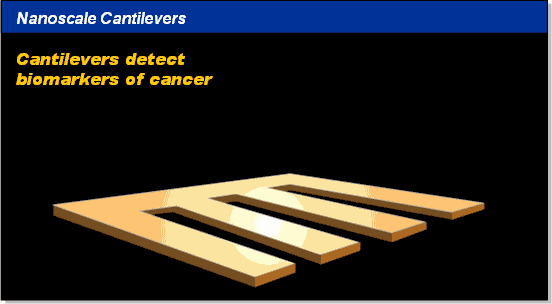top of page
A Bright Future:
Nanomedicine




1/3
Nanomedicine with Cancer
Nanotechnology provides an opportunity for researchers to manipulate macromolecules and study cancer cells in their early stages in an efficient way. Furthermore, it allows an accurate and rapid way of diagnosis of cancer cells, enabling scientists to record even the slightest mutation of cancer cells. First off, there are multiple ways to treat cancer using nanotechnology:
Nanowires
Nanowires are made in a nano sized scale and are sensitive genetic mutations and are able to relay information to the outside world. In addition, the metal-like object shown in the image on the right is a microfluidic channel, which is a technology responsible for manipulating and controlling fluids. With the help of the nanowires, scientists are able to pick up abnormal genes associated with cancer.
(C4)

Cantilevers

(C5)
Nano Cantilevers are like flexible diving boards shown in the picture. They are coated with molecules capable of binding substrates together. With many nano cantilevers working together, single molecules of DNA or protein are detectable. For instance, if a cancer cell secretes its own products, antibodies coated on the nano cantilevers bind to these proteins secreted by the cancer cell and changes the form of the cantilevers. As a result, Scientists are able to observe and study the changes and evaluate the concentration of these molecules.
Diagnosis for Cancer
The best way to fight cancer is to discover the tumor domain at an early stage and treat it as soon as possible. Nanotechnology provides a faster and earlier way to discover the existence of cancer cells, it also enables scientists to accurately locate the affected area. It can be done in two ways: Imaging and Screening.
Imaging
Screening
Imaging technology today can only detect cancer cells once it made visible changes to cell tissues. Fortunately, Nanotechnology gives us an opportunity to detect cancer cells with something specifically designed to detect cancerous cells and enables it to be seen. For example, Gold nanoshells can effectively locate the cancerous areas by shining a light through the skin of the patient and not damaging other tissues: "Nanotechnology will enable the visualization of molecular markers that identify specific stages and types of cancers, allowing doctors to see cells and molecules undetectable through conventional imaging". (C7)
Nanotechnology would soon revolutionize the detection of biomarkers. For example, Quantum dots "[w]hich emit light of different colors depending on their size, could enable the simultaneous detection of multiple markers" (C2). Because of the varieties of colors in the Quantum Dots, scientists are able to diagnose the cancer cells and locate them.

(C6)
Where does Cancer Nanotechnology Stand Today?
Where does Nanotechnology Stand Today? - Anna Barker
00:00 / 00:00
Dr. Anna Barker said that "Nanotechnology really employs functionality" It helps scientists to study how cancer evolves and develop themselves. In early stages of Nanotechnology, it is more preferable to take pills available in market because they directly treat cancer. Chemotherapy on the other hand had a greater possibility of damaging nearby cells as well. One of the breakthroughs in nanotechnology with cancer is a new nanoparticle that is able to detect as few as two cancer cells in one microliter of biospecimen.
September 30, 2010

Anna Barker, Ph.D., Former Deputy Director, NCI and Former Director, NCI Center for Strategic Scientific Initiatives (CSSI)
(C8)
(C9)
bottom of page